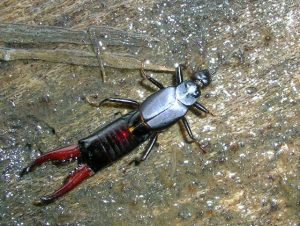 What are Earwigs?
What are Earwigs?
As one of the smallest insect orders, earwigs have only about 2,000 species total. They have pincers on their abdomen, and membranous wings that give them their order name that translates into “skin wings”. Rarely using their flying abilities, earwigs are nocturnal for the most part and hide in dark moist crevices in the day. They feed on insects and plants, causing damage to crops, flowers, and foliage. They may live under rocks and logs in flowerbeds because this is the area where all of their needs may be met.
The flowerbed provides a dark moist area to live as well as plants and insects for the earwig to feed on. Eating a wide variety of foliage, the common earwig may survive in just about any garden if the conditions are favorable for them.
Frequented Areas
Though there are only about 20 species of earwigs in North America, there are about 1,800 species worldwide. Striped earwigs, aka shore earwigs, are most common in the southern portion of the U.S. Earwigs tend to live in damp and moist areas, seeking shelter in the daytime as they are nocturnal. It should be noted that earwigs have caused major economic damage in Europe. Germany lost flowers, hops, and corn crops while the south of France saw the loss of peaches and apricots.
Identification and Physical Characteristics
In the United States, the three common types are European earwigs, red-legged earwigs, and striped earwigs. European earwigs are about 16mm long with a rust brown color and lighter wing covers. These are the type that are commonly encountered in the U.S. Red-legged earwigs can reach anywhere from 12 to 15 mm long and are colored either brown or black. Striped earwigs are a dark brown or reddish brown, and can grow from 20 to 25 mm long. These pests have six legs and three body segments. They do have curved pincers for their mouths, but these cause little to no harm to humans. The earwig nymphs (immature stages) look similar to the adults, but they do not have the wings.
Special Characteristics
Contrary to popular belief, earwigs do not burrow into the ears of people that are sleeping. There is no scientific

An earwig from the Western Ghats
proof that this is fact. The common earwig is an omnivore and also a scavenger. Their prey includes plant lice and large insects such as bluebottle flies. Scientists believe that the pheromones earwigs put out are the reason that they may get together and form a cluster. Earwigs also use their pincers for defense as well as sparing with other earwigs. These insects actually have the female that lays the eggs and then they hatch. The females are picky about where they lay the eggs and will only lay in an area that they feel is protected enough such as under we leaves and mulch or in other cracks and crevasses.
Earwigs are preyed upon by birds, lizards, centipedes, assassin bugs, and other insectivorous mammals. It is also still up for debate whether or not earwigs are beneficial to humans. While earwigs may live in a garden feeding on plants, they also feed on insects such as aphids, that consume the garden foliage. In the winter, earwigs spend their time burrowed in the ground, and the females lay their eggs in this burrow in the spring and she will tend to the eggs until they hatch.
Removal and Preventative Procedures
Any area that is wet and humid will look promising to an earwig. The best prevention for earwigs is to make conditions unsavory for them, which includes drying out any areas such as a crawl space that could harbor any excess moisture. Crawlspaces should also have a vapor barrier, not only to prevent earwigs but also to prevent fungus. Door sweeps should be closely fit on the bottoms of doors, and all window screens should be securely fit. Any holes in bricks should have screen placed over them to prevent entry for earwigs.
Application of Chemicals or Electronic Removal
It is suggested to leave any earwig infestation treatment with chemicals to the professionals. A pest control specialist or professional will be able to properly identify the type of earwig infestation, thus likely able to find the source. When the source is found it is possible to correct the situation, and then begin treatment for the earwigs.

No Comments